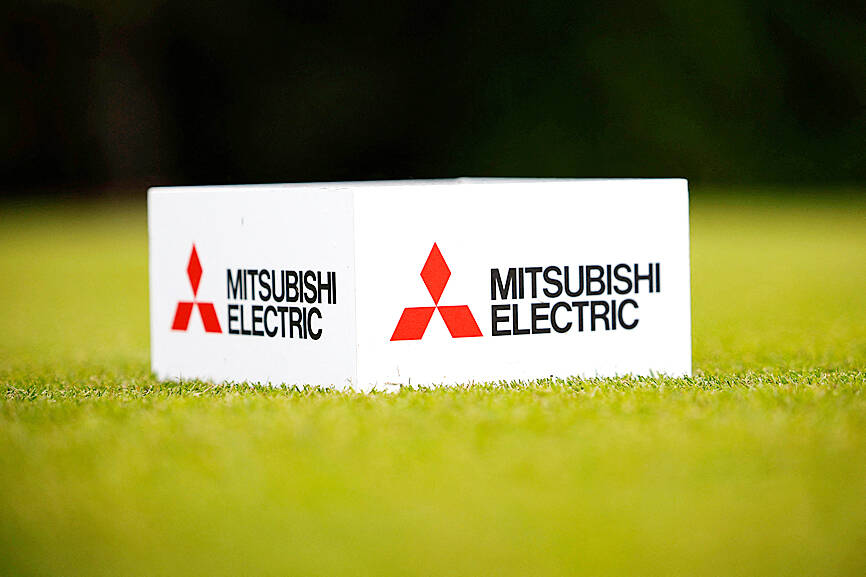Mitsubishi Electric Corp is struggling to meet sustained global demand for optical components used in data centers powering artificial intelligence (AI).
The Tokyo-based maker of factory automation is a key supplier of optic fiber communication devices that link servers to one another. AI’s appetite for high speed and high volume calculations is propelling sales of Mitsubishi Electric’s devices, which boast low power consumption and heat emission, said Masayoshi Takemi, an executive officer in charge of the company’s semiconductor and devices business.
The company next month plans to ramp up production capacity for optical devices to a level 50 percent above last year’s.

Photo: AFP
“But that won’t be enough to meet the strong level of inquiries we’re getting,” Takemi said in an interview. “We may need double what we’ll have in September.”
Mitsubishi Electric controls almost half of the global market for optical transmission devices in data centers, in part because of its electro-absorption modulated laser diodes’ ability to balance both speed and output, the company said.
It would not be an exaggeration to say all US hyperscalers are Mitsubishi Electric customers, Takemi said, without naming clients.
The US is home to some of the world’s biggest hyperscalers — Amazon.com Inc, Microsoft Corp, Alphabet Inc, Meta Platforms Inc and Apple Inc.
The executive’s comments are the latest sign of continued hunger for AI infrastructure, even as investors struggle to price the technology’s impact on companies’ sales.
Demand from the top five data center providers in the US is “very strong” and “still growing,” Takemi said.
Next-generation data centers are operating at speeds of 800 gigabits per second to 1.6 terabits per second, up from previous levels of about 400 gigabits per second, according to optical communications market research firm LightCounting.
Optical devices comprise a tiny part of Mitsubishi Electric’s business, which ranges from factory robots to train systems to power plant controls to satellite equipment. The semiconductor and devices arm earned less than 4 percent of the company’s revenue last fiscal year, with power semiconductors used in industrial machines and electric vehicles making up almost 90 percent of that sliver.
On Japan’s power chip sector, where Mitsubishi Electric competes with domestic rivals Rohm Co and Toshiba Corp, Takemi said he did not see an urgent need for consolidation. China is boosting output of such chips, providing heavy subsidies in a bid to raise its technological self-sufficiency.
Japan has also been beefing up support to boost production of such chips, but concern is growing that the nation could fall behind in a fragmented market.

SEEKING CLARITY: Washington should not adopt measures that create uncertainties for ‘existing semiconductor investments,’ TSMC said referring to its US$165 billion in the US Taiwan Semiconductor Manufacturing Co (TSMC, 台積電) told the US that any future tariffs on Taiwanese semiconductors could reduce demand for chips and derail its pledge to increase its investment in Arizona. “New import restrictions could jeopardize current US leadership in the competitive technology industry and create uncertainties for many committed semiconductor capital projects in the US, including TSMC Arizona’s significant investment plan in Phoenix,” the chipmaker wrote in a letter to the US Department of Commerce. TSMC issued the warning in response to a solicitation for comments by the department on a possible tariff on semiconductor imports by US President Donald Trump’s

The government has launched a three-pronged strategy to attract local and international talent, aiming to position Taiwan as a new global hub following Nvidia Corp’s announcement that it has chosen Taipei as the site of its Taiwan headquarters. Nvidia cofounder and CEO Jensen Huang (黃仁勳) on Monday last week announced during his keynote speech at the Computex trade show in Taipei that the Nvidia Constellation, the company’s planned Taiwan headquarters, would be located in the Beitou-Shilin Technology Park (北投士林科技園區) in Taipei. Huang’s decision to establish a base in Taiwan is “primarily due to Taiwan’s talent pool and its strength in the semiconductor

Industrial production expanded 22.31 percent annually last month to 107.51, as increases in demand for high-performance computing (HPC) and artificial intelligence (AI) applications drove demand for locally-made chips and components. The manufacturing production index climbed 23.68 percent year-on-year to 108.37, marking the 14th consecutive month of increase, the Ministry of Economic Affairs said. In the first four months of this year, industrial and manufacturing production indices expanded 14.31 percent and 15.22 percent year-on-year, ministry data showed. The growth momentum is to extend into this month, with the manufacturing production index expected to rise between 11 percent and 15.1 percent annually, Department of Statistics

An earnings report from semiconductor giant and artificial intelligence (AI) bellwether Nvidia Corp takes center stage for Wall Street this week, as stocks hit a speed bump of worries over US federal deficits driving up Treasury yields. US equities pulled back last week after a torrid rally, as investors turned their attention to tax and spending legislation poised to swell the US government’s US$36 trillion in debt. Long-dated US Treasury yields rose amid the fiscal worries, with the 30-year yield topping 5 percent and hitting its highest level since late 2023. Stocks were dealt another blow on Friday when US President Donald